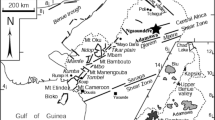Abstract
The Loch Ba ring-dyke in the Tertiary igneous central complex of Mull, N.W. Scotland is composed predominantly of a banded rhyolitic welded tuff. The rhyolite contains numerous inclusions of dark aphanitic rock. The textural relationships between the different rocks indicate rapid, violent and intimate mixing during emplacement of the dyke. The dark glassy component varies continuously from basaltic andesite to andesite, dacite and rhyolite. These glasses are enriched in FeO and depleted in MgO at a given SiO2 content in comparison to other tholeiitic highly differentiated volcanic rocks. The rhyolite contains an average of 4% phenocrysts and is associated with the mineral assemblage plagioclase (An32 to An21)-sanidine(Or50–60)-hedenbergite-fayalite-magnetite-ilmenite-apatite-zircon. Mineral aggregates involving either plagioclase-hedenbergite-ilmenite or plagioclase-fayalite-magnetite are common, but aggregates containing fayalite and hedenbergite together are scarce. The dark glassy components are either phenocryst free or contain less than 0.2% phenocrysts. The main phenocrysts associated with the dark glasses are plagioclase (An65-An30), high calcium clinopyroxene ranging continuously from augite to pure hedenbergite, pigeonite, magnetite, ilmenite and rare apatite. Zoning in minerals is generally weak or absent. The plagioclase feldspar, high calcium clinopyroxenes and pigeonites have similar compositional ranges to the minerals observed in the Middle and Upper Zones of the Skaergaard Intrusion. The mineral compositions are systematically related to SiO2 content and Mg number of the glasses. The data demonstrate that mineral compositions and assemblages similar to the Skaergaard form from silica-rich andesitic to rhyolitic liquids. The various mafic glasses are interpreted to have been derived from a zoned magma chamber underlying an upper layer of rhyolitic magma. Differentiation is attributed to fractional crystallization of the observed mineral assemblages causing SiO2 enrichment and FeO depletion. However, glasses with less than 57% SiO2 have unusual compositions with very low MgO and P2O5 as well as variable Al2O3 and TiO2. Their peculiarities could be explained by andesitic magmas assimilating cumulate mineral aggregates precipitated from more differentiated dacite and rhyolite magmas. The bulk compositions of these cumulates have high FeO, low SiO2 and negligible MgO and P2O5. It is suggested that the high density of the mineral aggregates containing fayalite-hedenbergite-magnetite and ilmenite caused them to settle through the zoned chamber to be assimilated by high temperature, less differentiated magmas.
Similar content being viewed by others
References
Bailey EB, Clough CT, Wright WB, Richey JE, Wilson GV (1924) Tertiary and post-Tertiary geology of Mull, Loch Aline and Oban, Mem Geol Survey Scotland
Brown WL, Parsons I (1981) Towards a more practical two-feldspar geothermometer. Contrib Mineral Petrol 76:369–377
Carmichael ISE (1964) The petrology of Thingmuli, a Tertiary volcano in eastern Iceland. J Petrol 5:435–460
Fridrich CJ, Mahood GA (1987) Compositional layers in the zoned magma chamber of Grizzly Peak Tuff. Geology 15:299–303
Huppert HE, Sparks RSJ, Wilson JR, Hallworth MA (1986) Cooling and crystallization along an inclined plane. Earth Planet Sci Lett 79:319–328
Hunter RH, Sparks RSJ (1987) The differentiation of the Skaergaard intrusion. Contrib Mineral Petrol 95:451–461
Lewis JD (1968) Form and structure of the Loch Ba ring dyke, Isle of Mull. Proc Geol Soc Lond 16:110
Marshall LA (1984) Origin of mixed magma and net-veined ring intrusions. PhD thesis, University of Cambridge
McBirney AR (1975) Differentiation of the Skaergaard intrusion. Nature 253:691–694
McBirney AR (1985) Further considerations of double-diffusive stratification and layering in the Skaergaard intrusion. J Petrol 26:993–1001
McBirney AR, Baker BH, Nilson RH (1985) Liquid fractionation. Part I: Basic principles and experimental simulations. J Volcanol Geothermal Res 24:1–24
Philpotts AR (1982) Compositions of immiscible liquids in volcanic rocks. Contrib Mineral Petrol 80:201–218
Reedman AJ, Park KH, Merriman RJ, Kim SE (1987) Welded tuff infilling a volcanic vent at Weolseong, Republic of Korea. Bull Volcanol 49:541–546
Richey JE (1932) Tertiary ring structures in Britain. Trans Geol Soc Glasgow 19:42–140
Scott RB (1971) Alkali exchange during devitrification and hydration of glasses in ignimbrite cooling units. J Geol 79:100–109
Sigurdsson H, Sparks RSJ (1981) Petrology of rhyolitic and mixed-magma ejecta from the 1875 eruption of Askja, Iceland. J Petrol 22:41–84
Thompson RN (1980) Askja 1875, Skye 56 Ma: basalt triggered plinian, mixed magma eruptions during the emplacement of the Western Red Hills granite, Isle of Skye, Scotland. Geol Rundsch 69:245–262
Thompson RN (1983) Thermal aspects of the origin of Hebridean Tertiary acid magmas. Experimental melting behaviour of the granites of 1 kilobar pH2O. Min Mag 47:111–122
Wager LR (1960) The major element variation of the Layered Series of the Skaergaard intrusion and a re-estimation of the average composition of the hidden layered series and of the successive residual magmas. J Petrol 1:364–398
Wager LR, Brown GM (1968) Layered igneous rocks. Oliver and Boyd, Edinburgh London, pp 588
Walker GPL, Skelhorn RR (1966) Some associations of acid and basic igneous rocks. Earth Sci Rev 2:93–109
Walsh JN, Beckinsale RD, Skelhorn RR, Thorpe RS (1979) Geochemistry and petrogenesis of Tertiary granitic rocks from the island of Mull, Northwest Scotland. Contrib Mineral Petrol 71:99–116
Watson EB (1976) Two liquid partition coefficients: experimental data and geochemical implications. Contrib Mineral Petrol 56:119–134
Watson EB (1982) Basalt contamination by continental crust: some experiments and models. Contrib Mineral Petrol 80:73–87
Wolff JA, Wright JV (1981) Rheomorphism of welded tuffs. J Volcanol Geothermal Res 10:13–34
Wood DA (1978) Major and trace element variations in the Tertiary lavas of East Iceland and their significance with respect to the Iceland geochemical anomaly. J Petrol 19:393–436
Author information
Authors and Affiliations
Rights and permissions
About this article
Cite this article
Sparks, R.S.J. Petrology and geochemistry of the Loch Ba ring-dyke, Mull (N.W. Scotland): an example of the extreme differentiation of tholeiitic magmas. Contr. Mineral. and Petrol. 100, 446–461 (1988). https://doi.org/10.1007/BF00371374
Received:
Accepted:
Issue Date:
DOI: https://doi.org/10.1007/BF00371374




